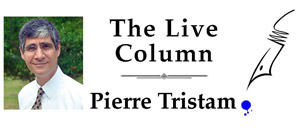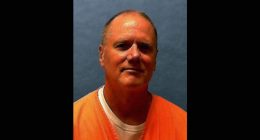
I don’t know what Palm Coast and Flagler County governments were thinking when they imagined it a fabulous idea to plant a mini-Meadowlands in the middle of sprawlingly residential U.S. 1 and obstinately suburban Palm Coast.
 Let’s not play into the focus-group-tested euphemism and call it a “fuel farm,” as if it were some bucolic scene out of Christina’s World. The fuel dump would have massed the equivalent of 17 Palm Coast water towers filled with 12.6 million gallons of diesel and gas. It would have required a new rail yard, terminus for 125-car trains filled to capacity and riding the at-times rickety lines of the Florida East Coast Railroad, whose 2008 derailment of hazardous chemicals in Favoretta should not be white noise.
Let’s not play into the focus-group-tested euphemism and call it a “fuel farm,” as if it were some bucolic scene out of Christina’s World. The fuel dump would have massed the equivalent of 17 Palm Coast water towers filled with 12.6 million gallons of diesel and gas. It would have required a new rail yard, terminus for 125-car trains filled to capacity and riding the at-times rickety lines of the Florida East Coast Railroad, whose 2008 derailment of hazardous chemicals in Favoretta should not be white noise.
It would have been the in-and-out traffic of 35,000 fuel tanker trucks a year, or 70,000 trips rumbling along Christina’s actual world of picket fences and chrome-addled SUVs in fuming distance of subdivisions like Sawmill Branch and Somerset, the latter cleared for construction just last week.
It would have required a leap of faith to believe that Belvedere Terminals, a start-up company with zero experience in the field and a CEO with two bankruptcies under his belt and a worrisome history in South Florida, could pull off a fossil-fuel miracle. With Palm Coast as guinea pig. And to do it just as we’re getting away from dirty fuels. It’s as if Manhattan had converted Central Park to a horse-and-buggy barnyard just as Henry Ford’s Model T’s were rolling off assembly lines.
This is what projects subsidized by fossil-fueled Florida gets you. The state was putting up $10 million for the county to buy the land. Since Jeb Bush’s go-go years in the 2000s the state hasn’t seen a development regulation it couldn’t scrap and an “economic development” gamble it couldn’t ram down past home rule and environmental legacies. The state is so blinded by its hatred for electric cars and green energy that it can’t see past the diesel fumes of its losing battle. Even if the fuel dump were built, it would have been a monument to stupidity when it would be an oily white elephant struggling to survive not too many years from now.
So who in local government imagined that a county that approves environmentally sensitive land referendums by 3-to-1 margins would embrace a fuel monument to oil’s gushier days?
Maybe you can’t blame lawmakers and Belvedere’s brass for knowing zilch about Palm Coast. To them U.S. 1 here was what U.S. 1 is for most of its 2,400 miles up and down the East Coast–the country’s single-greatest exuberance of commercial chaos and aesthetic antimatter. Maybe previous city councils infatuated with residential development and the myth that it pays for itself shouldn’t have rezoned those long stretches of U.S. 1 to more houses. But that’s history.
And in retrospect, to accuse previous councils of poor planning is like accusing past Flagler Beach city commissions for forbidding high-rises along State Road A1A. Surely the high rises would have rained taxdollars on the city’s tiny treasury. But who among you will cast a stone against a decision that has carved out a rare sanctuary of oceanfront sights and public access on the East Coast? U.S. 1 isn’t oceanfront. But it doesn’t have to be Newark, either.
The push for the dump was also tied to another myth: that somehow Palm Coast’s overwhelmingly residential tax base is unsustainable. That its tax burden is lopsidedly on residential homes. That commercial and industrial development lowers property taxes. The premises are taken as gospel in this county and never tested. Not one of them is true.
First, Palm Coast is already among the least-taxed cities in the state despite the large residential tax base. The problem here is too low a tax rate and zero municipal and franchise taxes on utilities. That’s what’s unsustainable. Look around at your crumbling infrastructure and overburdened parks. We can’t even pave our streets with more than cheap sealants or give our local sports leagues enough space to play on.
Second, Duval/Jacksonville, Miami, Tampa, Orlando, Melbourne, Daytona Beach all have higher tax rates than Palm Coast–and proportionately more commercial and industrial properties. The split has nothing to do with it. The more you urbanize, the higher the cost of keeping things civilized. Incidentally, St. Johns County has a lopsided residential housing tax base and a tax rate 42 percent higher than Palm Coast’s. It also has the best schools in the state and one of its lowest unemployment rates (even though county taxes are independent of schools). What has our lower tax base gotten us?
Third, the problem with property taxes is structural. The Save our Homes cap of 3 percent on property tax increases and the homestead exemption and its “portability” schemes have created a monster of unfairness, with renters and commercial properties subsidizing the homesteaded, whose taxes have fallen sharply in inflation-adjusted terms: the property appraiser valued my house at $153,000 in 2010, a couple of years after we bought it. We paid $2,150 in taxes. It is now valued at $323,000, a 111 percent increase. Our tax bill: $2,154. If our bill had just kept up with inflation, it would have been $3,173. So in real terms, we have benefited from a 32 percent decrease in taxes, while robbing local government of that 32 percent in purchasing power.
We don’t have high taxes. We have a perverse tax system that lawmakers want to pervert further, with the governor pandering to the homesteaded with a $1,000 rebate they don’t need and the speaker of the house looking to rob the treasury and local governments of a combined $6 billion by cutting the sales tax to 5.25 percent.
That’s why, aside from that spate of Covid-era newcomers shocked that their tax bill was higher than the previous owners of their own house, you rarely see homeowners clamoring to the City Council or the County Commission for a property tax break. You never see them bitching about the industrial-residential split, about which they simply don’t care. The only people who do, and only when they’re trying to ram a dubious “economic development” plan down our throats, are chamber of commerce types who stand to make a buck off the scheme, along with whatever bunch of government saps they’ve convinced to sell the plan on their behalf. That’s why it’s called a dump.
There are smarter ways to grow, starting with reading the room. Most people don’t move to Palm Coast to work here but to retire or live in a quiet, green bedroom community and work elsewhere. Data centers might fit in. Fuel dumps don’t. Palm Coast residents quickly saw through the scheme. The City Council thankfully did read the room and stopped it. But there’ll be more. Selling the city’s soul to make a buck is always one vote away. Cue the $110 million sports complex.
![]()
Pierre Tristam is the editor of FlaglerLive. A version of this piece airs on WNZF.









